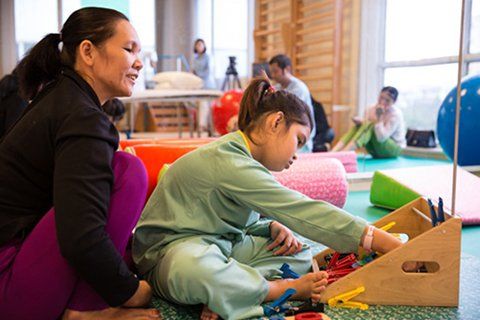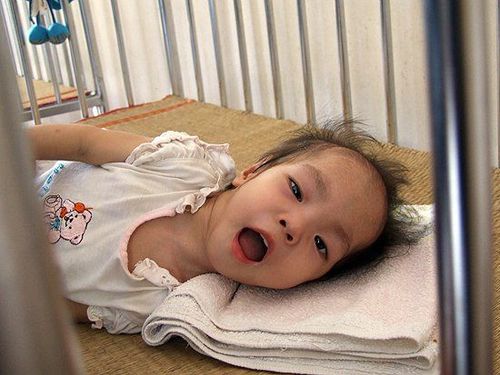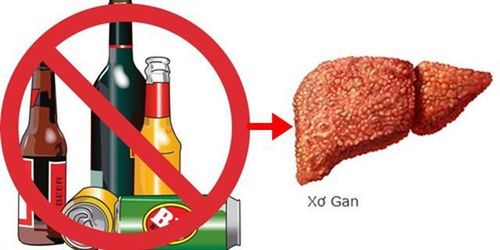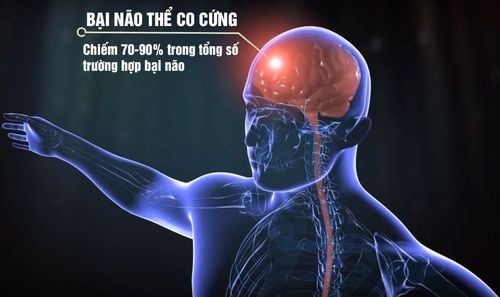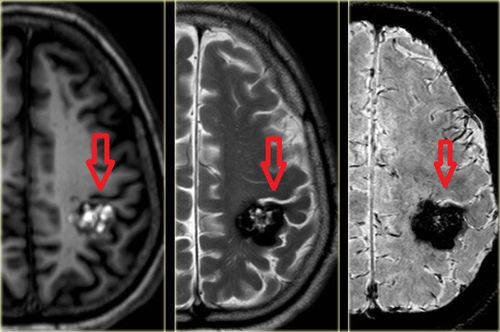This is an automatically translated article.
Cerebral palsy is a difficult disease to diagnose in the early postpartum period because the signs are not clear. However, parents can notice abnormal changes in their children through early treatment, which helps to improve the child's control function and brain activity.1. Diagnosis of cerebral palsy
The signs and symptoms of cerebral palsy get better over time. Children are usually diagnosed with cerebral palsy when they are a few months old. Children suspected of having cerebral palsy will be evaluated by a doctor for signs and symptoms of cerebral palsy, monitored for growth and development, taken into account medical history, and ordered to undergo general physical examination. The doctor may then refer you to a doctor who specializes in neurology or other brain diseases (pediatric neurologist, physiotherapist and rehabilitation physician). pediatric function). Your doctor may also order a variety of tests to diagnose and rule out other causes.
1.1 Brain scan Brain imaging technology can help see damaged or abnormally developed areas in the brain. These tests may include:
MRI : An MRI scan uses radio waves and a magnetic field to create detailed 3D or cross-sectional images of a child's brain. MRI often helps identify lesions or abnormalities in the brain. This test is painless, but noisy, and can take up to 1 hour to complete. The child will be given general anesthesia or local anesthesia before. Cranial Ultrasound: Cranial ultrasound can be performed during the neonatal period. The method uses high-frequency sound waves to create images of the brain. Ultrasound does not produce detailed images, but can be ordered because it is quick, inexpensive, and can also provide a preliminary assessment of the brain. Electroencephalogram (EEG): If a child is suspected of having a seizure, an EEG can further evaluate the condition. Seizures are the hallmark of a child with epilepsy. During an EEG test, a series of electrodes are attached to a child's scalp. An EEG records electrical brain activity to look for changes in brain wave patterns that help diagnose epilepsy.
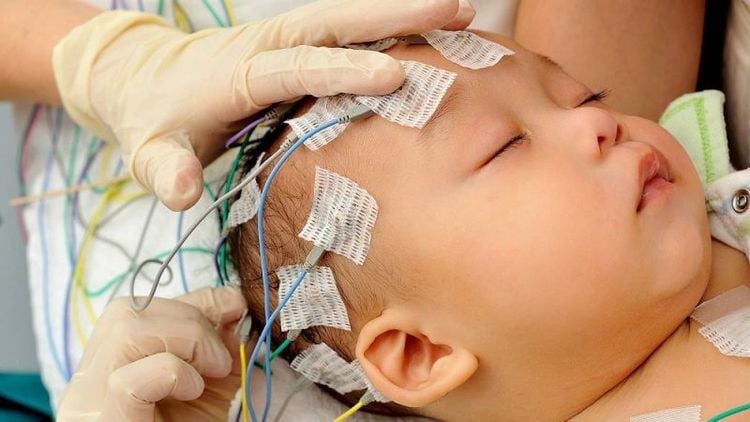
Điện não đồ (EEG) giúp phát hiện và chẩn đoán bại não ở trẻ
1.2 Lab tests Blood, urine, or skin tests may be used to screen for genetic or metabolic problems.
1.3 Other Diagnostic Methods If your child is diagnosed with cerebral palsy, you will likely be referred to specialists to check your child for other conditions commonly associated with the disorder. . These tests can identify problems with:
Vision Hearing Language ability Intelligence Motor development
2. Treatment of cerebral palsy
Children and adults with cerebral palsy need long-term care by a medical care team. Cerebral palsy can be treated by a combination of pediatricians and pediatric neurologists and mental health professionals.
2.1 Medications Drugs that relieve muscle tension may be used to improve brain function, relieve pain, and manage complications related to spasticity or other cerebral palsy symptoms.
Injections that affect nerves or muscles To improve the function of a particular muscle, your doctor may give your child onabotulinumtoxinA (Botox, Dysport) or another medicine. Your child will need injections about every 3 months. Side effects may include pain at the injection site and mild flu-like symptoms. Other serious side effects include difficulty breathing and swallowing.
Oral muscle relaxants Medicines such as diazepam (Valium), dantrolene (Dantrium), baclofen (Gablofen, Lioresal) and tizanidine (Zanaflex) help relax muscles. Side effects of these drugs include drowsiness, changes in blood pressure and the need to monitor the risk of liver damage. Diazepam has a high risk of side effects, so long-term use is not recommended. In some cases, baclofen is injected into the spinal cord with a tube based on surgical implantation under the skin of the abdomen. Your child may also be prescribed medication to reduce drooling, such as Botox injections into the salivary glands.
2.2 Therapeutics A variety of therapies play an important role in the treatment of cerebral palsy including:
Physical therapy: Muscle training and exercises can help children to be strong, flexible, and balanced. balance and develop motor skills. You'll also learn how to safely take care of your baby's daily needs at home, such as bathing and feeding. During the first 1-2 years postpartum, both physical and occupational therapists assist with issues such as head and trunk control, rolling over, and hand holding. Then, combine these two methods to help children practice mobility with a wheelchair.

Các phương pháp trị liệu giúp trẻ thích nghi được với các kỹ năng vận động và cảm xúc
Occupational/Functional Therapy : The aim of the method is to help the child gain independence in daily activities and routines at home, school and in the community. Recommended adaptive devices for children include walkers, quads, seats, or electric wheelchairs. Speech therapy: Methods that can help improve a child's ability to speak or communicate using sign language, teaching the use of communication devices, such as computers and speech synthesizers, if communication is difficult. difficulty. Difficulty eating and swallowing can also be resolved. Recreational therapy: Some children benefit from regular or adaptive recreational or competitive sports activities, such as therapy horseback riding or skiing. This type of therapy can help improve a child's motor skills, speech, and emotions. 2.3 Surgery Surgery may be needed to relieve muscle tension or correct skeletal abnormalities caused by spasticity. Treatments include:
Orthopedic surgery: Children with severe contractures or deformities may need bone or joint surgery to put their arms, hips or legs in the correct position. Surgery can also lengthen muscles and shorten tendons. These procedures can relieve pain, improve mobility, and make it easier to use a walker or crutches. Nerveectomy (selective lumbar spondylectomy): In some severe cases, when other treatments don't respond, surgeons may cut the nerve that serves the spastic muscles in the spine. a procedure called selective spondylolysis. This relaxes the muscles and relieves pain, but can cause numbness. 2.4 Stem cell transplantation for cerebral palsy Some children and adolescents with cerebral palsy use some form of complementary or alternative medicine. These therapies are not accepted in clinical practice. For example, hyperbaric oxygen therapy is widely promoted for the treatment of cerebral palsy despite evidence of ineffectiveness. Controlled clinical trials involving therapies such as hyperbaric oxygen therapy, exercise using special clothing, mobility aids for children, and certain forms of electrical stimulation have not been conducted. concluded or showed no benefit to date. Stem cell therapy is being explored as a treatment for cerebral palsy, but research is still evaluating whether it is safe and effective.
70 - 80% of patients after stem cell transplant for cerebral palsy have improved in motor function, significantly reduced muscle tone, increased muscle strength, better coordination in activities, increased sensation appetite and weight gain, improved concentration skills, better memory...
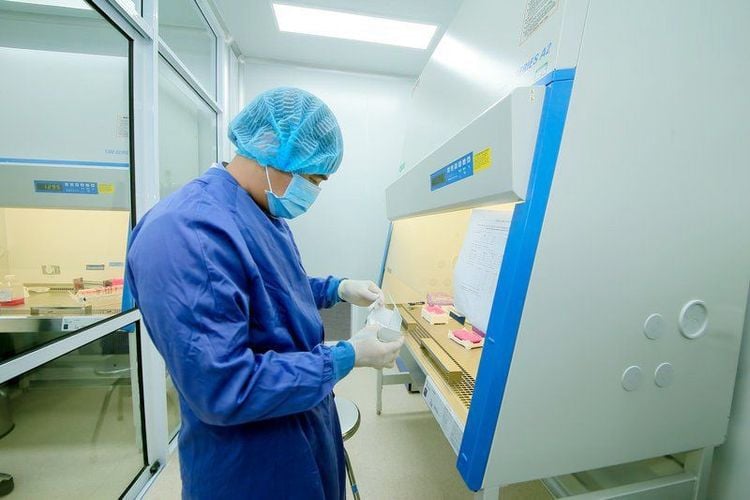
Ghép tế bào gốc điều trị bại não tại Bệnh viện Đa khoa Quốc tế Vinmec Times City
3. Advice for parents of children with cerebral palsy
When a child is diagnosed with cerebral palsy, the whole family faces new challenges. Here are a few tips for taking care of your child and yourself:
Promote your child's independence : Encourage all your child's independent endeavors, no matter how small. Be an advocate for your child: You are an important part of your child's health care. Don't be afraid to speak up on your child's behalf before your child's doctor, therapist, and teacher. Find support: A circle of support can make a big difference in helping you and your family cope with cerebral palsy and its effects. As a parent, you may feel grief and guilt about your child's disability. Your doctor can help you locate support groups, organizations, and counseling services in your community. Your child may also benefit from family support programs, school programs, and counseling.
Vinmec Times City International General Hospital has applied stem cell method to successfully treat many cases of cerebral palsy that seemed to have lost all hope. The whole process of stem cell transplantation for cerebral palsy at Vinmec is performed very closely, ensuring safety in accordance with international standards. All surgeries are performed by leading experts and doctors with modern machinery and medical equipment.
In addition, Vinmec has also developed a standard transplant procedure so that it can share experiences with colleagues, creating more opportunities for treatment for children with cerebral palsy across the country.
All information about treating cerebral palsy by stem cell transplantation at Vinmec Hospital, Customers can directly visit the hospital for examination or contact hotline 0243 9743 556 for support.
References : Mayoclinic.org and Cdc.gov




